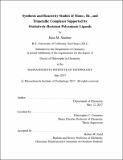| dc.contributor.advisor | Christopher C. Cummins. | en_US |
| dc.contributor.author | Stauber, Julia M. (Julia Megan) | en_US |
| dc.contributor.other | Massachusetts Institute of Technology. Department of Chemistry. | en_US |
| dc.date.accessioned | 2017-12-05T16:24:31Z | |
| dc.date.available | 2017-12-05T16:24:31Z | |
| dc.date.copyright | 2017 | en_US |
| dc.date.issued | 2017 | en_US |
| dc.identifier.uri | http://hdl.handle.net/1721.1/112361 | |
| dc.description | Thesis: Ph. D., Massachusetts Institute of Technology, Department of Chemistry, 2017. | en_US |
| dc.description | This electronic version was submitted by the student author. The certified thesis is available in the Institute Archives and Special Collections. | en_US |
| dc.description | Cataloged from student-submitted PDF version of thesis. | en_US |
| dc.description | Includes bibliographical references. | en_US |
| dc.description.abstract | Investigations of the oxidatively-resistant hexacarboxamide cryptand, mBDCA-5t-H₆, to support mono-, bi-, and trimetallic complexes are presented. Selective single metal ion insertion into the cryptand was achieved to generate the mono-Co(II) and Zn(II) complexes that contain proximal hydrogen-bonding networks enforced by the carboxamide N-H groups of the pre-organized second-coordination sphere. The cobalt(II) complex serves as a selective colorimetric turn-on fluoride sensor and represents a unique example of a transition-metal based fluoride sensor where fluoride binding takes place directly at the transition metal. The binding of fluoride is synergistic involving hydrogen-bond donors from the second-coordination sphere together with metal(II) ion coordination. Isolation of the mono-metallic Co and Zn complexes allowed for the preparation of their transition and main group metal heterobimetallic variants. Hetero- and homobimetallic complexes of cobalt(II) and zinc(II) are presented, and the reactivity of the homobimetallic complexes with O₂, O-₂ , and H₂O₂ is discussed. The cryptand was also explored as a supporting ligand for cofacially arranged divalent group 14 ions (Ge, Sn, Pb). Reaction of the di-tin(II) complex with elemental sulfur or selenium generates di-tin polychalcogenide complexes containing [mu]-E and bridging [mu]- E₅ ligands (E = Se, S), where the sulfur-containing product acts reversibly as a source of S3 '- in DMF solution. The di-tin(II) complex also serves as a bidentate ligand for the preparation of trimetallic Sn₂/M complexes (M = Ag(I), Au(I), Pd(0)). Reactivity studies of the Sn₂/Pd(0) complex with substrates including CS₂, S₈, and ¹AdCaP are described. Terminal titanyl complexes supported by oxidatively-resistant tri- and tetrametaphosphates were prepared as molecular models of heterogeneous oxidation catalysts. These complexes react with hydrogen peroxide to produce the corresponding peroxotitanium( IV) metaphosphates, and represent rare examples of titanium oxo and peroxo systems supported by an all-oxygen ligand environment. | en_US |
| dc.description.statementofresponsibility | by Julia M. Stauber. | en_US |
| dc.format.extent | 296 pages | en_US |
| dc.language.iso | eng | en_US |
| dc.publisher | Massachusetts Institute of Technology | en_US |
| dc.rights | MIT theses are protected by copyright. They may be viewed, downloaded, or printed from this source but further reproduction or distribution in any format is prohibited without written permission. | en_US |
| dc.rights.uri | http://dspace.mit.edu/handle/1721.1/7582 | en_US |
| dc.subject | Chemistry. | en_US |
| dc.title | Synthesis and reactivity studies of mono-, bi-, and trimetallic complexes supported by oxidatively-resistant polyanionic ligands | en_US |
| dc.type | Thesis | en_US |
| dc.description.degree | Ph. D. | en_US |
| dc.contributor.department | Massachusetts Institute of Technology. Department of Chemistry | |
| dc.identifier.oclc | 1008888097 | en_US |
